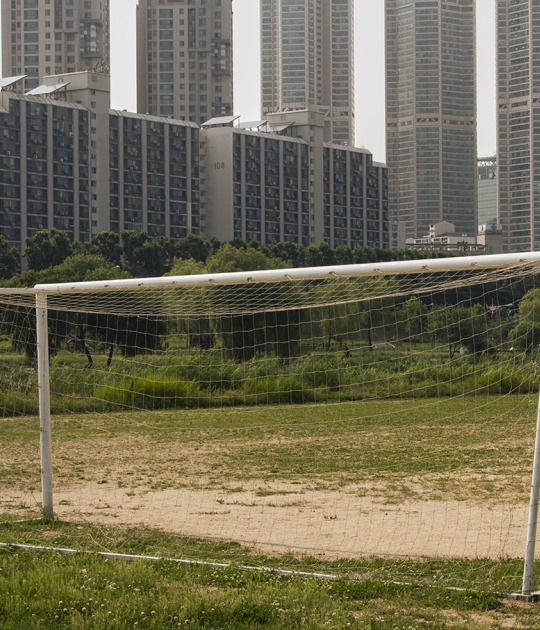Arina Dähnick has photographed Mies van der Rohe buildings all over the world since she discovered the Neue Nationalgalerie in 2012 under the light of a thunderstorm and took photos of it until its closure in 2015 under different atmospheric conditions. The images of her play with the perception of the viewer offering a multilayer reading of the buildings of the German architect and making use of various photographic techniques, such as blurring and focus.
Description of project by Fundació Mies van der Rohe
Fundació Mies van der Rohe and CaixaForum present “The MIES Project. Architectural Portraits”, a photographic Mies van der Rohe Pavilion and CaixaForum. The opening took place on Thursday 6 May at 18h with a conversation between the artist and Michelangelo Sabatino which marked the start of the programme of activities proposed by the entity for Barcelona Architecture Week.
This is the first time that photographer Arina Dähnick presents her work in Barcelona and she will do it simultaneously in two emblemàtic, neighbouring spaces: the Mies van der Rohe Pavilion and CaixaForum Barcelona.
Her delicate photographs portray the details of Mies van der Rohe’s works in different lighting and weather conditions that interact with the buildings and become architectural portraits.
Urban life and urbanity, the contrasts between indoors and outdoors, the lack of definition and focus, reflections and mirror images, the play with the viewer’s perception: these aret he pictorial topics of the photographer. Arina Dähnick discovered Ludwig Mies van der Rohe’s architecture in 2012, when, after an electric storm, she perceived Neue Nationalgalerie as a fascinating and paradoxical spacial experience of unlimited immensity, and a simultaneous feeling of being retained. Since then, she photographed the building under different conditions until its closing in 2015. The photographer followed Mies van der Rohe’s steps from Berlin to Brno, from Chicago to New York and captured his most famous buildings, including the Mies van der Rohe Pavillion, Villa Tugendhat, the Seagram Building and the Lake Shore Drive Apartments, in some impressive series of potos that convey her creative inspiration and the spatial experience of architecture itself.
This photographic project, previously presented at the IIT College of Architecture in Chicago, the Farnsworth House in Plano and Villa Tugendhat in Brno, arrives now in Barcelona to interact with the city’s visitors.
“Certainly, these images are not just formal architectural photography, they represent a different way of seeing and reveal a poetic quality in Mies’s work that has so far largely been undiscovered. Dähnick works without a tripod, and while these images are not staged, they are nevertheless composed by a very discerning eye that often captures a moment that is not repeatable.”
Dirk Lohan, architect, Chicago
“The MIES Project reveal how, contrary to what advocates of postmodernism have claimed, Mies’s buildings engaged with their surrounding context. Thus, with their reflections and shadows, Arina Dähnick ’s architectural portraits add yet another layer of understanding to the complex legacy of Ludwig Mies van der Rohe."
Michelangelo Sabatino, architect, preservationist and architecture-art-design historian, Chicago
The presentation of the photographs is complemented by the publication Arina Dähnick – Architectural Portraits. The MIES Project.
Inventory of the presented work
11 photos at CaixaForum:
2 images Mies van der Rohe Pavilion, 1 Seagram Building, 1 IBM Building, 1 Farnsworth House, 2 Federal Centre, 1 S. R. Crown Hall, 1 Lake Shore Drive Apartments, 2 images900- 910 esplanade.
Photographs taken in the years 2017-2019
12 photos at Pavilion:
3 images Neue Nationalgalerie, 2 images Pavilion Mies van der Rohe, 2 Seagram Building, 2 Tugendhat House, 2 Farnsworth House, 1 Lemke House.
Photographs taken in the years 2013-2019
About the artistic interventions program at Mies van der Rohe Pavilion
Interventions by plastic artists devised for the Mies van der Rohe Pavilion normally take the form of installations or small-scale, short-term exhibitions.
This programming of the Pavilion’s exceptional spaces brings a unique type of activity to the city. The installations are a way of maintaining an active dialogue and giving sense to the Pavilion’s continuing topicality. A periodicity of 1-2 projects per year is planned, ensuring a proper balance between artistic and architectural contributions.
About the Pavilion
The Barcelona German Pavilion was designed by Lilly Reich and Ludwig Mies van der Rohe as the German national pavilion for the 1929 Barcelona International Exhibition that was held in Montjuïc. This symbolic piece of work of the Modern Movement has been exhaustively studied and interpreted, while inspiring the work of several generations of architects. Built from glass, steel and different kinds of marble, the Pavilion was conceived to accommodate the oficial reception presided over by King Alfonso XIII of Spain along with the German authorities.
After the closure of the Exhibition, the Pavilion was disassembled in 1930. As time went by, it became a key point of reference not only in Mies van der Rohe’s own career but also in twentieth-century architecture as a whole. Given the significance and reputation of the Pavilion, thoughts turned towards its possible reconstruction.
In 1980, Oriol Bohigas promoted this initiative from the Urban Planning Delegation of the Barcelona City Council, and architects Ignasi de Solà-Morales, Cristian Cirici and Fernando Ramos were the ones appointed to the research, design and direction of the reconstruction of the Pavilion. Works began in 1983 and the new Building was inaugurated in 1986 on its original site.
Fundació Mies van der Rohe was created in 1983 by Barcelona’s City Council with the initial aim of carrying out the reconstruction of the German Pavilion. In addition to preserving and disseminating knowledge about the Mies van der Rohe Pavilion, the Fundació promotes debate and awareness on contemporary architecture and urban Planning issues.
































